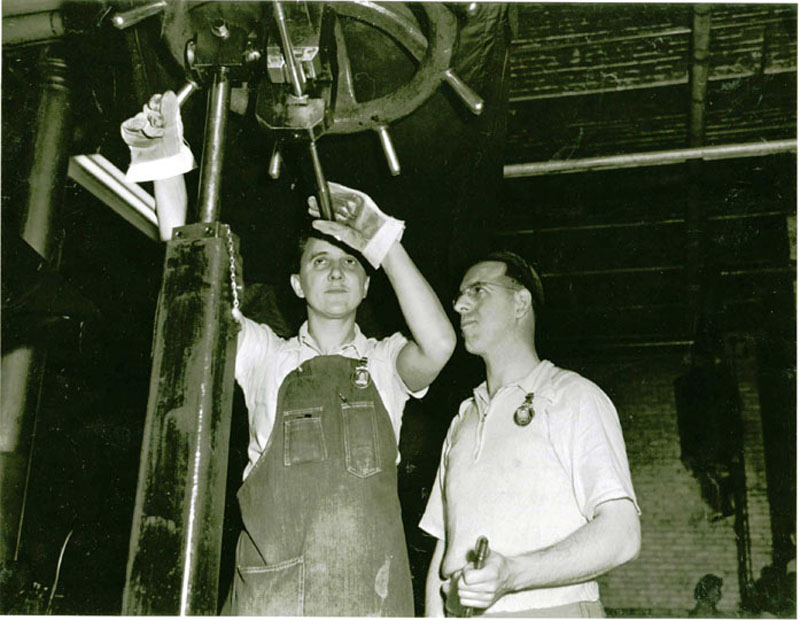
The AFGE fought for the rights of Armory workers during WWII
Well into World War II, several disputes between workers and management arose
at the Armory in which the American Federation of Government Employees (AFGE)
Lodge 431 played a part. The union believed that, in issuing orders to civilians,
the uniformed officers at the Armory were overstepping the boundaries set by
Civil Service rules. The union itself, however, was not universally acknowledged
as the civilians' representative in negotiations with management. The longer-employed
supervisors, who were organized as the "20-year
Club," tended to prefer relying on Congressional and Civil Service protection,
and to put more faith in getting amendments passed to laws affecting all government
plants. The managers looked askance at the AFGE, whose meetings in 1944 drew
attendance of about 200 but which claimed 5000 paid-up members. It evaded submitting
a roster of membership, while the other smaller union, the National Federation
of Federal Employees local, did so, showing a membership of about 145. Management
felt that any union should play an advisory role only, since legislation and
Civil Service rules left so little scope to the Armory itself for determining
its own conditions.
After proposing formation of a Labor-Management Committee in March, 1944,
the AFGE subsequently rejected it when the management insisted on including representatives
from the other union, AFFE, and the 20-years Club, and would not give AFGE more
weight on the committee. This left them to rely on direct representations to
the commanding officer, and on newspaper publicity. The issues at stake were
management fairness in requesting draft deferments for individual Armory men,
and how much weight to give seniority in making inter-department transfers and
promotions. The Works Manager, Lt. Col. Huth, was accused of favoritism in promoting
a certain foreman of lesser seniority to civilian head of Manufacturing Inspection.
The AFGE went to Washington to appeal to the Chief of Ordnance, who upheld Huth's
decision.

A barrel straightener is inspected as she does her job
Despite having lost face in this fight, the AFGE leaders took on the task
in mid-summer 1944 of representing the rod-straighteners who had (illegally)
gone on strike for six days to protest a cut in the piece rate for straightening
rods, mentioned above. They wanted their work records cleared of bad marks due
to their strike, but the commanding officer refused to do so, and the Chief of
Ordnance also rejected their appeals. The AFGE then broadened the attack through
the press by charging waste and mismanagement at the Armory, and threatening
to carry the campaign to the House Committee for Military Affairs unless the
Ordnance Department investigated the situation. An investigation by the
Ordnance Department ensued, even though the AFGE attempted to retract its demand
for one, but the investigation did not support the charges.
In the course of this dispute the commanding officer died and was replaced,
but the new one also ran afoul of the AFGE late in 1944 in his handling of a
request by 46 foremen for clarification of their status relative to the officers
assigned to their shops. The AFGE then in time-honored manner called on Massachusetts
Congressmen and Senators for a non-military investigation of the Armory, charging
that the dual military-civilian management of the shops was intrinsically wasteful
and that veto of the civilian foremen by their uninformed officer counterparts
was dictatorial. The AFGE called for civilian supervision of the Armory, retaining
officers only for product inspection. Their campaign for an investigation ran
on into 1945. It was espoused by Massachusetts Senator Walsh, but with little
result beyond the three-day suspension of the AFGE president for spreading
false statements after he equated the authority of "schoolboy" officers
over skilled craftsmen with fascism. The war's imminent end suspended the union's
campaign for demilitarizing Armory management. About half of the 9,000 men
and women in the wartime work force were laid off after V-E Day in the spring
of 1945; the AFGE president himself resigned and ran for [Springfield] city council.
The AFGE labor disputes were the last in Armory history and appear to have
been a side-effect of unusually large and rapid growth of the Armory labor force,
military as well as civilian. By the time the AFGE disputes began, virtually
all Armory officers were from the reserves, as wartime demands swept up regular
Ordnance Department officers for other assignments. Thus the disputes grew
from friction between parties with little if any Armory experience. During most
periods, management reliance on the skills and experience of workers--critical
elements in achieving Armory standards of interchangeability--tended to minimize
potential conflict.
|